
hotline:
17715390137
Tel/Wechat:
18101240246 (Technology)
0512-68565571
Email:mxenes@163.com (Sales Engineer)bkxc.bonnie@gmail.com
Scan the code to follow or search the official account on WeChat:
2D Materials Fronrier After paying attention,
click on the lower right corner to contact us,
Enter enterprise WeChat.
Professional Services Online

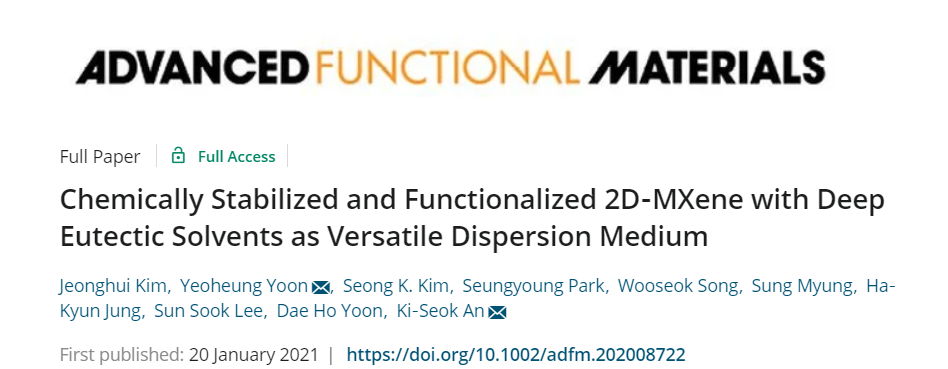
Generally, MXenes are synthesized in acidic solutions and separated in alkaline solutions. This gives it unique physical/chemical properties and can be used as a general-purpose material suitable for various practical applications. However, the chemical treatment of the solution will affect the chemical structure of MXene, thereby accelerating the oxidation reaction and destroying its inherent properties. This paper demonstrates the long-term stable dispersion of MXene in deep eutectic solvents (DESs), and the dispersion can resist up to 28 weeks of oxidative degradation. As an anti-oxidant dispersion medium, DES can passivate the surface of MXene due to the donor and acceptor of hydrogen bonds, thus helping to prevent the oxidation of the MXene layer. In addition, the DES molecules in the dispersion can also be hydrated in the presence of water to stabilize active oxygen by forming stable DES water clusters. Therefore, the use of DES enhances the delamination of MXene nanosheets, and at the same time prevents the oxidation of nanosheets in solution or even in a dry state. The results show that compared with the original MXene, the thick film and thin film of MXene dispersed with DES exhibit stable sheet resistance. In addition, the MXene dispersed in the DES can be used as an electrode of an electrochemical capacitor. Compared with the original MXene, it shows higher chemical stability and better performance. The related paper is titled "Chemically Stabilized and Functionalized 2D-MXene with Deep Eutectic Solvents as Versatile Dispersion Medium" published in the top international journal Advanced Functional Materials (IF=16.836).
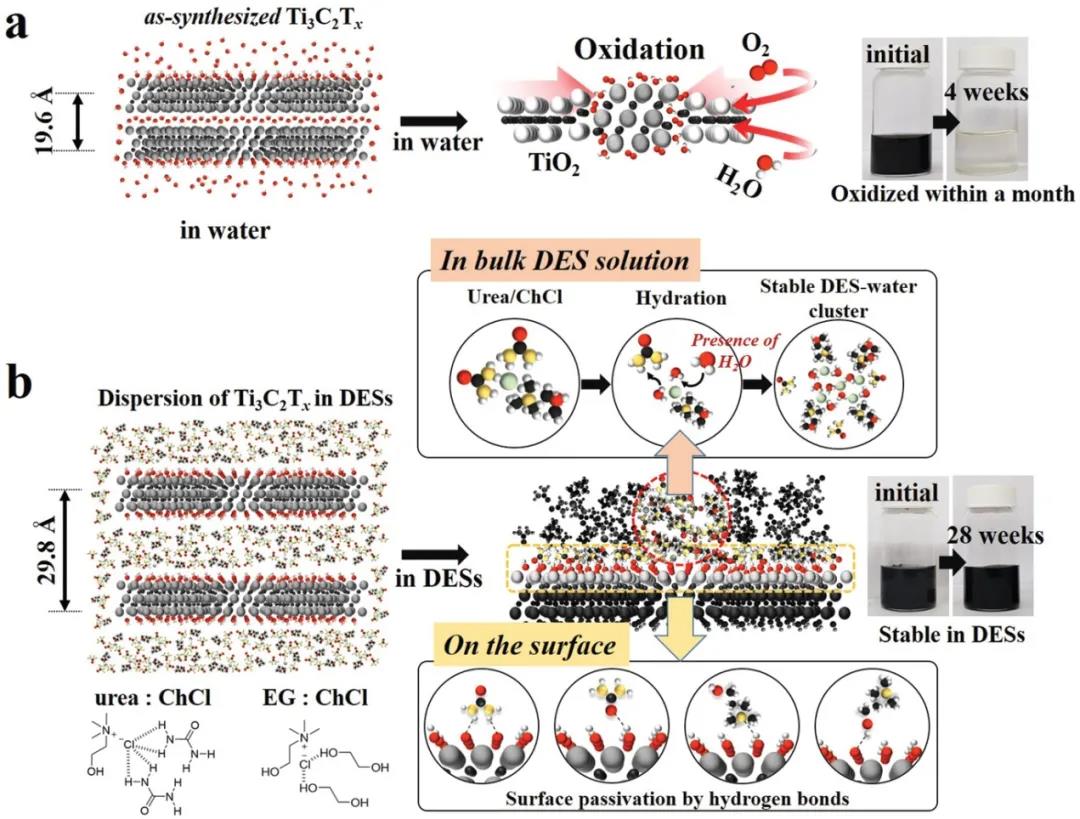
First, the author compared three MXene dispersions, among which i) deionized water (w-MXene), ii) urea-based DES (u-MXene) or iii) EG-based DES (e-MXene) as solvents to verify: DES successfully inserted MXene and enhanced layering through a simple dispersion process. Because only HF is used to etch MXene. However, delamination requires additional steps, such as DMSO or ammonium intercalation, so the author tried to replace the traditional intercalant with DES to delaminate the MXene stripped by HF. X-ray diffraction (XRD) tests were performed to analyze the crystal structure of samples dispersed in 3 different media (Figure 2a). These results indicate that negatively charged MXene promotes the spontaneous intercalation of DES molecules, leading to an increase in the c-LP value of MXene. Then, the author tried to layer MXene. Since the van der Waals forces of u-MXene and e-MXene are weaker than w-MXene (represented by the larger interlayer distance), both DES embedded MXene samples successfully delaminated. Figure 2b shows the XRD pattern of an independent MXene membrane prepared by vacuum filtration of each layered MXene solution (using dimethylformamide (DMF), N-methyl-2-pyrrolidone (NMP) and Diluted dispersions such as ethylene glycol (EG)). Figure 2c shows a photo of w-MXene, u-MXene and e-MXene samples dispersed in high concentrations (above). No matter what kind of dispersion medium is used, the initial dispersion state is very good, especially at high concentration (10mg/mL), even after dilution with DMF, they are all stably dispersed (below). Therefore, an independent membrane can be easily formed by simple suction filtration (Figure 2d). In addition, the authors performed thermogravimetric analysis (TGA) to further explore the embedded evidence and confirm the thermal stability of all three samples. Figure 2e compares the weight loss of the three powder samples heated to 800°C in a nitrogen atmosphere. This weight loss trend is similar to the weight loss trend of pure DES solvent, which further proves that the molecules inserted between the layers are thermally decomposed or evaporated. In addition, atomic force microscopy (AFM) imaging was performed to characterize the thickness of each layered MXene nanosheet (Figure 2f-h). AFM images show that some single-layer MXene nanosheets (with a thickness of about 2nm) have a lateral dimension of micrometers. Their 2D properties were well maintained in the initial state (unoxidized); therefore, all samples were successfully delaminated.
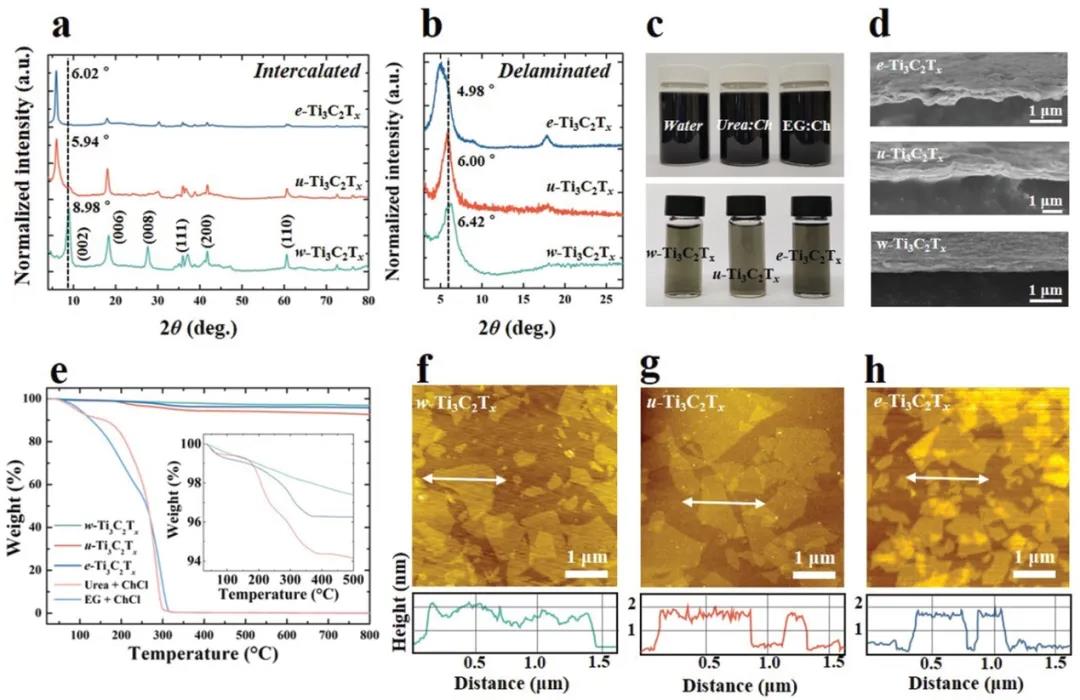
Figure 2. Layering of MXene in DES a) XRD pattern of MXene powder (w-MXene, u-MXene and e-MXene) and b) independent film.
c) Photograph of MXene dispersion (top: high concentration (10mg/mL); bottom: low concentration (0.2mg/mL)) and d) cross-sectional SEM image of the independent membrane.
e) TGA diagram of u-MXene, blue: e-MXene.
f-h) AFM images (above) and corresponding line profiles of all MXene nanosheets deposited on SiO2 substrate.
【Chemical oxidation stability in liquid phase】
This section focuses on possible changes in the structure of MXene due to continuous oxidation in the dispersion. In order to characterize the possible chemical structural transformations of w-MXene, u-MXene and e-MXene with the extension of oxidation time, the author performed XPS analysis. Figure 3a-c shows the high-resolution Ti2p nuclear energy level spectra of all samples. Even after storage for 7 months, no chemical structure changes were observed in u-MXene or e-MXene (Figure 3b, c). In addition, the author conducted a control experiment to confirm that the MXene in DES also did not oxidize at high temperatures. These results indicate that the high chemical inertness of DES makes it a good dispersion medium and further prevents the oxidation of MXene. In addition, as shown in Figure 3d, the zeta potential was determined to characterize the surface charge transition over time. Wash all samples and redisperse them with water (diluted as shown in Figure 1c before measuring to exclude other factors except surface oxidation). It can be seen that the nitrogen intensity (≈400eV) in the XPS survey spectrum caused by DES decreases before and after washing. As shown in Figure 3e-h, SEM characterizes the morphology of the sample. The prepared MXene showed a unique accordion-like multilayer structure (Figure 3e). It is worth noting that after 8 weeks of oxidation, many oxide particles were clearly observed between the layers of the w-MXene sample (Figure 3f), which is consistent with the XPS results. In contrast, no oxide particles or defects were observed in u-MXene and e-MXene samples (Figure 3g, h).
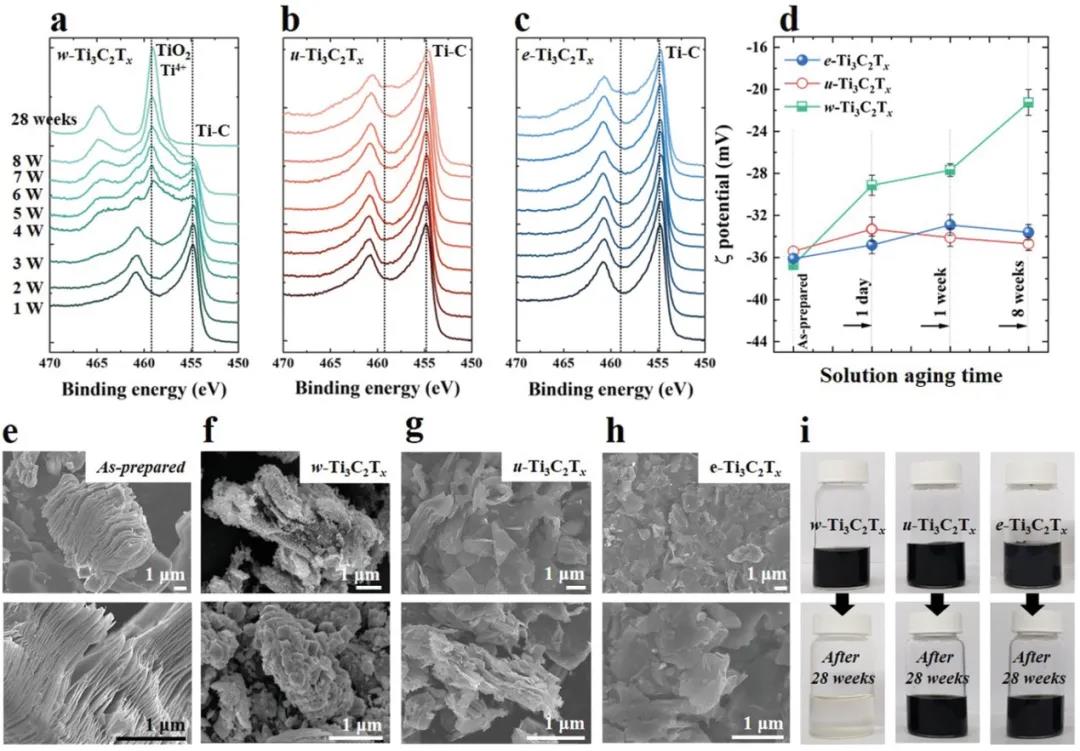
Figure 3. The chemical oxidation stability of the solution phase is a function of oxidation time. Time-related Ti2p core energy level spectrum: a) w-MXene, b) u-MXene and c) e-MXene. d) Time-dependent zeta potential diagrams of all MXenes. e) Prepared multi-layer MXene, f) w-MXene, g) u-MXene and h) FE-SEM image of e-MXene. i) The photo of the initial dispersion state of MXene (top) and the photo after 28 weeks of oxidation (bottom).
In addition, the authors used TEM to characterize the nanoscale changes in surface oxidation of w-MXene, u-MXene and e-MXene (Figure 4). Regardless of the dispersion medium, the initial morphology of the MXene flakes showed no signs of titanium oxide crystals (Figure 4a-c, top images). As expected from the previous results, after 8 weeks of oxidation in water, many TiO2 particles were observed on the surface of the w-MXene flakes (Figure/4a, bottom image), which is considered to be direct evidence of oxidation. The images in Figure 4b and c respectively show the TEM images of u-MXene and e-MXene; even after 8 weeks of oxidation in the DES medium, the layered structure can be observed. There are no atomic-level TiO2 crystals or clusters on the surface of MXene, which shows that dispersing MXene in DES will not affect the 2D hexagonal properties and can successfully prevent oxidation.
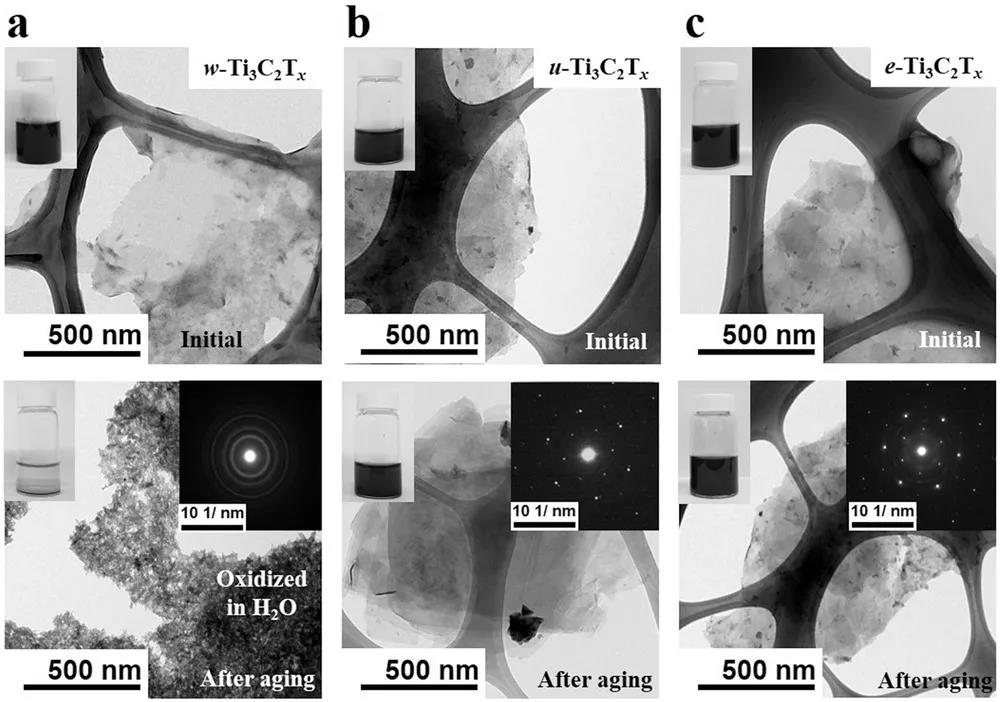
Figure 4. TEM analysis results. TEM images (HR-TEM) of the initial state (top) and 28 weeks later (bottom) of all samples. Illustration: The corresponding SAED mode.
[Oxidation stability of dried samples]
Above, the author has verified the oxidation stability of MXene in the solution phase through spectroscopy and microscopy. In this section, in order to determine how the oxidation progresses and how to resist oxidation during the drying stage, the authors prepared thin films (≈60nm) and thick films (≈35μm) by spraying and filtering methods and chemical/physical methods respectively. The change of oxidation performance with time under atmospheric conditions is analyzed. The author compared thin and thick films because it was assumed that the oxidation mechanism of oxygen diffusion would be different. Figures 5a-c show the SEM images of three different MXene thick films after being oxidized in the dry phase for 8 weeks under atmospheric conditions. Interestingly, there are signs of morphological transformation at the edge of the w-MXene sheet (Figure 5a), which is not visible in the initial state. In addition, since oxidation occurs under atmospheric conditions, the grain boundaries of w-MXene nanosheets can be clearly observed. This further proves that the oxidation reaction starts from the edges and defect parts, and also proposes a new strategic method for studying the defects of MXene. Compared with w-MXene, the independent films of u-MXene and e-MXene showed no structural degradation on the surface (Figure 5b, c), indicating that oxidation can be effectively prevented. However, it has been confirmed that although the oxidation reaction does not significantly penetrate the membrane, the oxidation reaction is still proceeding on the dried MXene surface. In addition, MXene composites, regardless of the amount of polymer added, show a decrease in conductivity, which indicates that the polymer has no antioxidant effect. Therefore, nano-level passivation is required to prevent oxidation of the MXenes surface. Figure 5f shows the optical properties of all samples tested using the UV method. In addition, the transmittance of the film made of w-MXene on the glass substrate changed from 42% to ≈80% at 550nm (photo illustration Figure 5f), which also confirmed that the entire laminate film (even the inner layer) is It is oxidized to TiO2 due to the diffusion of oxygen molecules. Therefore, even after 1 week of oxidation in air, the sheet resistance of the film increased significantly (Figure 5g). These differences were also observed in the dry phase of thick and thin films, indicating that the DES molecules also effectively stabilize the dry phase samples. This is an unexpected result, so the author further studied its underlying mechanism by analyzing the XPS N1s spectra of all samples oxidized in air for 8 weeks (Figure 5h). As shown in Figure 5h, the author believes that the urea molecules from DES are mainly adsorbed on u-MXene, because the shoulder peak of primary amine is observed at 399.8eV, while ChCl is adsorbed on e-MXene (blue curve). XPS and XRD results show that urea or ChCl (although not in a separate state) in DES plays a key role as an intercalating agent and surface passivation group, as well as an antioxidant that stabilizes water molecules by forming DES water clusters .
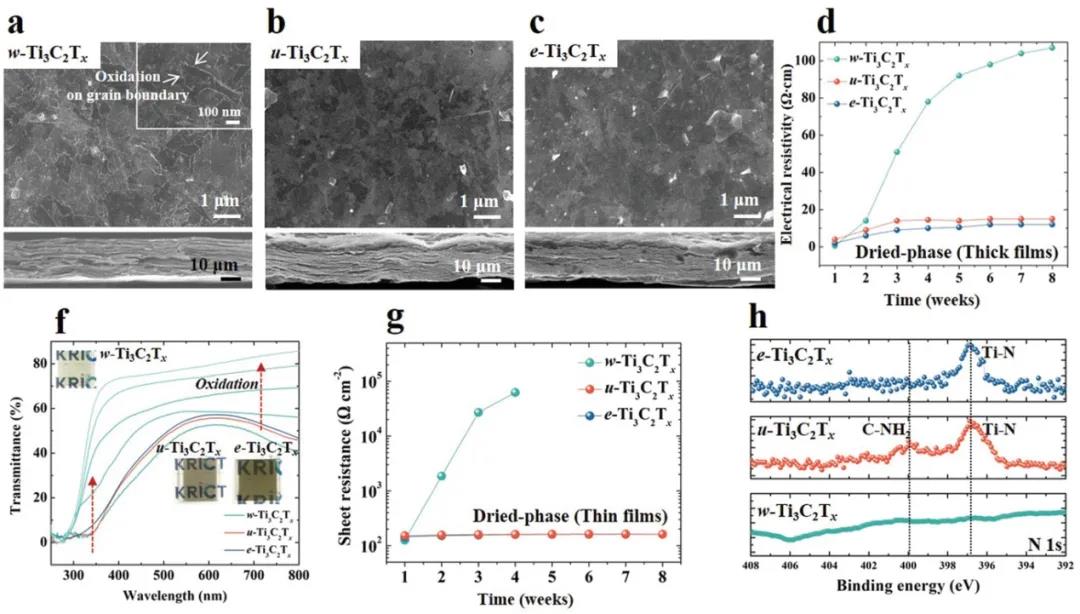
Figure 5. The chemical oxidative stability of w-MXene, u-MXene and e-MXene dry phase changes with time.
a-c) SEM images, d) resistivity over time, and f) UV-vis transmission spectrum of a stand-alone film after oxidation under atmospheric conditions for 8 weeks.
g) Time-dependent sheet resistance of the thin film on the glass substrate.
h) N1s core energy level spectrum of all films oxidized in the atmosphere for 8 weeks.
【Electrochemical characteristics】
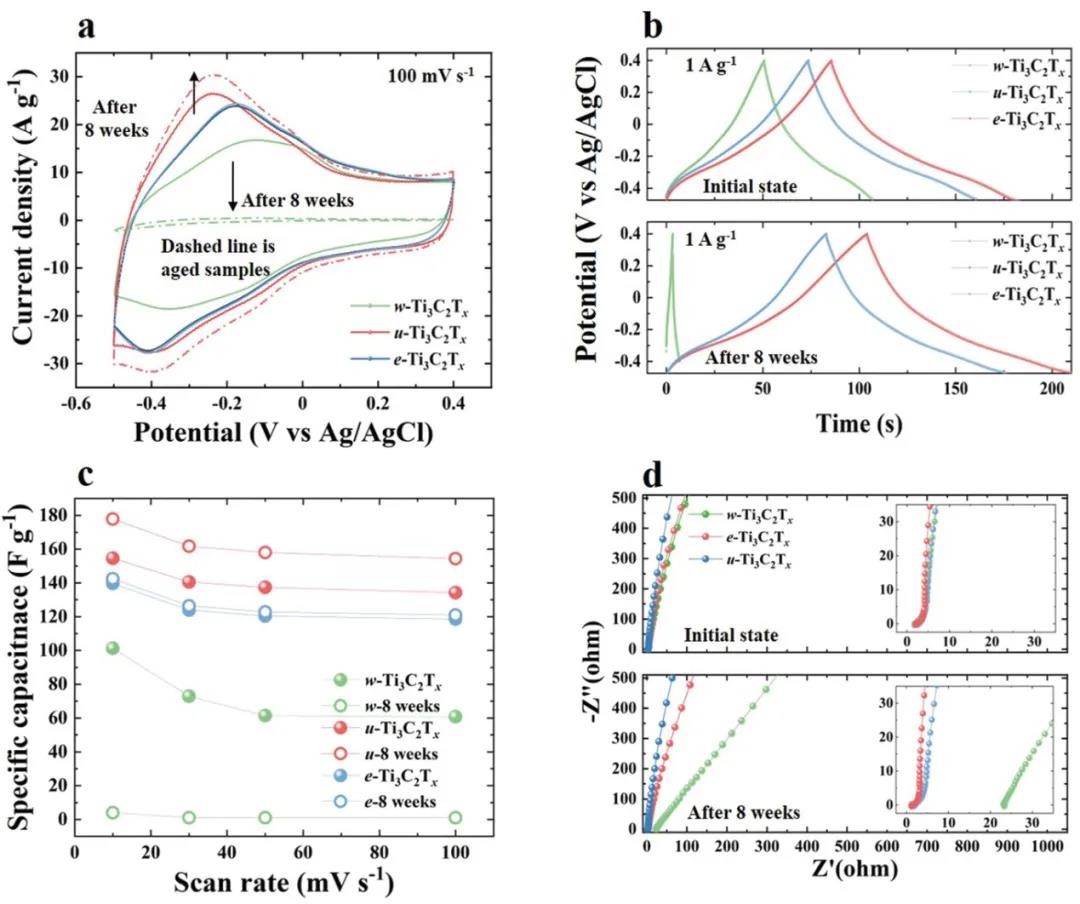
Figure 6. Electrochemical characteristics.
a) CV curve of MXene electrode before and after oxidation at 100mVs-1 in 1mH2SO4 electrolyte for 8 weeks.
e) The constant current charge and discharge curve is under 1Ag-1.
c) Weight capacitance performance before and after oxidation.
f) Nyquist plots of all samples before and after oxidation.
to sum up
In this paper, a simple dispersion method was used to prepare DESs as an antioxidant dispersion medium and induce the formation of a highly stable MXene dispersion. DES acts as an active material for the insertion and delamination of the MXene layer, and the surface passivation through hydrogen bonding further provides long-term chemical oxidation stability (up to 28 weeks) for the layered MXene layer. In addition, DES can be stably hydrated, so DES water clusters are formed in the presence of water, which prevents water molecules from participating in oxidation. This simple method will help expand the applicability and reliability of MXene in practical applications. Researchers who are troubled by the dispersion and oxidation of MXene can download the original text to read this article. In addition, the use of DES can provide more functions for MXene, such as the use of DES layered MXene to enhance electrochemical performance. In addition, the manufacture of DES-assisted MXene layering solution is very simple, and the low cost and green certification of DES molecules make it the most useful for the long-term stable manufacture and storage of MXene and other 2D materials.
Hopeful candidates, even on an industrial scale.
Literature link:
https://doi.org/10.1002/adfm.202008722

| Reminder: Beijing Beike New Material Technology Co., Ltd. supplies products only for scientific research, not for humans |
| All rights reserved © 2019 beijing beike new material Technology Co., Ltd 京ICP备16054715-2号 |